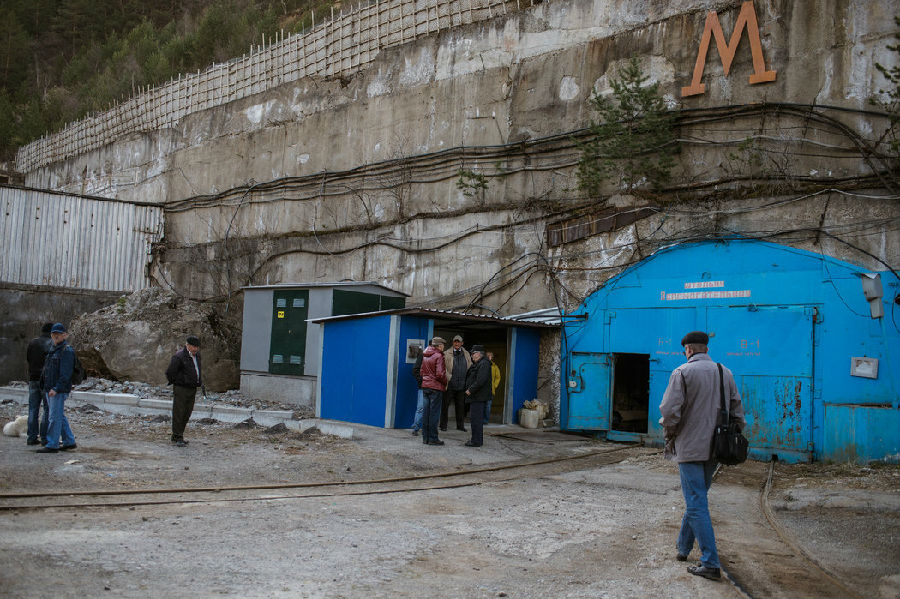(单词翻译:单击)
Just over the border from Georgia, in the Caucasus Mountains of southern Russia, lies a small town called Neytrino. For the last half-century, its main business has been the study of the tiniest insubstantial bit of matter in the universe, an ephemeral fly-by-night subatomic particle called the neutrino.
在俄罗斯南部高加索山脉比邻格鲁吉亚的地方,有一个名叫涅特里诺的小镇。在过去的半个世纪里,这个小镇上的主要工作是研究宇宙中最微小、最虚无缥缈的物质,即很难捕捉到的、转瞬即逝的中微子。
This is the home of the Baksan Neutrino Observatory, a warren of tunnels and laboratories burrowed two miles into a mountain, sheltered from the outside universe and cosmic rays underneath 12,000 feet of rock. There vats of liquid wait to record the flight of neutrinos from the center of the sun, from exploding stars, atomic reactors and the Big Bang itself, carrying messages through time. Neutrinos are the ghost riders of the cosmos, mostly impervious to the forces, like electromagnetism, with which other denizens of nature interact. Neutrinos cruise unmolested through rocks, the earth and even our bodies. In the words of a famous poem by John Updike, they “insult the stallion in his stall.”
巴克桑中微子观测站就坐落在这个小镇上。这个建在一座大山下的观测站由狭小的隧道和实验室组成,从山洞口进去约有3.6公里,上面覆盖着3500多米厚的岩石,以减少来自宇宙外部的宇宙射线的影响。一桶桶的液体在这里等待着记录不同来源的、携带着穿越时空信息的中微子,它们有的来自太阳的中心,有的来自爆炸的恒星,有的来自核反应堆,也有的来自大爆炸本身。中微子是宇宙中的幽灵骑手,它们基本上不受电磁这样的力量影响,不像其他的自然万物那样会与之相互作用。中微子能不受干扰地穿越岩石、土壤,甚至不知不觉地穿越我们的身体。正如约翰·厄普代克(John Updike)那句名诗所说,它们敢于“冒犯马厩中的牡马”。
The most delicate measurements so far indicate that an individual neutrino weighs less than a millionth what an electron weighs. Baksan is not the only place dedicated to their surreal pursuit.
目前为止最精确的测量显示,中微子的质量不到电子质量的百万分之一。巴克桑不是唯一致力于这种超现实事业的地方。
The men and women in these photographs, taken by Maxim Babenko last year, share an underground union with scientists scattered around the world in equally deep places: the Sanford Underground Research Facility in the former Homestake gold mine in Lead, S.D.; the Gran Sasso National Laboratory, beneath the mountain of that name in Italy; the Sudbury Neutrino Observatory in Ontario, Canada; the Super-Kamiokande, deep within Mount Ikeno, Japan; and IceCube, an array of detectors buried in ice at the South Pole.
马克西姆·巴本科(Maxim Babenko)去年拍摄的这些照片中的男男女女们,与世界各地的深地实验室的科学家们同属于一个地下联盟。这些深地实验室包括:位于美国南卡罗来纳州里德一座废弃金矿里的桑福德地下研究所(Sanford Underground Research Facility),位于意大利同名山脉下的格兰萨索国家实验室,位于加拿大安大略省的萨德伯里中微子观测站(Sudbury Neutrino Observatory),位于日本池野山深处的超级神冈观测站(Super-Kamiokande),以及埋在南极下面冰层中的一个名为冰立方(IceCube)的探测器阵列。
All of them are trying to listen to quantum whispers about the nature of reality. One of Baksan’s biggest claims to fame to date was to catch neutrinos emitted by thermonuclear reactions in the center of the sun in nearly 60 tons of liquid gallium. The experiment, called S.A.G.E., for Soviet-American Gallium Experiment, proved that scientists actually do know what powers our favorite star, source of our life and light.
所有这些中微子实验室的工作者们都在试图倾听量子中透露的实在本质。到目前为止,让巴克桑最有名的成就之一是,用近60吨的液态镓捕捉到了太阳中心的热核反应发射的中微子。这个名为“苏联-美国镓实验”(Soviet-American Gallium Experiment,简称SAGE)的实验证明,科学家的确知道是什么在驱动我们最爱的恒星,地球上生命和光的来源。
Since the fall of the Soviet Union, the scientists in Baksan have had to fend off both thieves and the Russian government to keep their gallium, an element that goes for some $500 a kilogram. Physicists know that neutrinos come in at least three flavors, known as electron, muon and tau neutrinos, depending on their subatomic origin. To add to the confusion, neutrinos have a kind of quantum superpower: They can molt from one type to another, sort of like a jail escapee changing clothes as he flees. An electron neutrino, say, can emerge from a nuclear reactor in one place and appear in a detector somewhere else as a muon neutrino. This complicates the cosmic accounting of these creatures.
自从苏联解体之后,巴克桑的科学家们为了保护他们的镓,不得不同时抵御盗贼和俄罗斯政府,镓是一种每公斤售价500美元的元素。物理学家们知道,中微子至少有三种,由于其不同的亚原子起源,中微子被分为电子中微子、μ中微子和τ中微子。更让其难以琢磨的是,中微子有一种量子超能:它们可以从一种变成另一种,就像是一个越狱者在逃跑过程中换了衣服似的。比如,一个地方的核反应堆中释放的电子中微子,可以以μ中微子的形式出现在另一个地方的探测器中。这给计算宇宙中这种粒子的数量制造了困难。

Physicists are arguing intensely these days over whether there is evidence for a fourth type, called sterile neutrinos. That is the object of a new experiment called B.E.S.T., for Baksan Experiment on Sterile Transitions, now underway in the rusty Baksan tunnels. Although neutrinos are the lightest and flimsiest and perhaps most fickle particles of the universe, they are also among the most numerous, outnumbering the protons and electrons that make up us and ordinary matter by a billion to one. And so neutrinos contribute about as much mass to the universe as the visible stars.
如今的物理学家们一直在激烈争论是否有证据表明存在着第四种中微子,即惰性中微子。这是正在巴克桑老旧隧道中进行的名为“惰性转换巴克桑实验”(Baksan Experiment on Sterile Transitions,简称BEST)的新实验所研究的对象。虽然中微子是宇宙中最轻、最透明、或许也是最易变的粒子,但它们也是数量最多的一种,比构成人和普通物质的质子和电子多十亿倍。所以中微子对宇宙质量的贡献与可见恒星的贡献差不多。
An extra population of neutrinos discovered by scientists in a cave in the Caucasus would affect basic calculations of the expansion of the universe. The discovery this month of a high-energy neutrino from a far distant galaxy passing through the IceCube detector at the South Pole elicited headlines around the world.
如果科学家在高加索山脉的洞穴里找到了以前不知道的中微子的话,那会影响宇宙膨胀的基本计算。南极的冰立方探测器本月检测到从其中经过的、来自遥远星系的高能中微子,这一发现引起了全世界的关注。
Meanwhile, unaware that they are being harassed by extraterrestrial visitors, horses graze outside Baksan, and life goes on, whether we understand it or not.
不知道自己受到外星访客骚扰的马儿们,正在巴克桑观测站外面的山上吃草。不管我们了解与否,生命一如既往。


